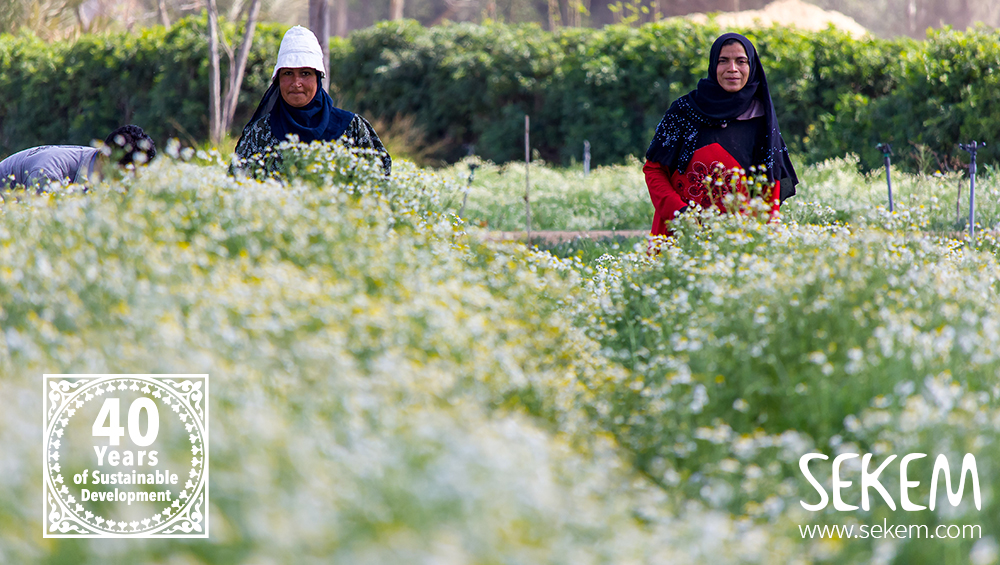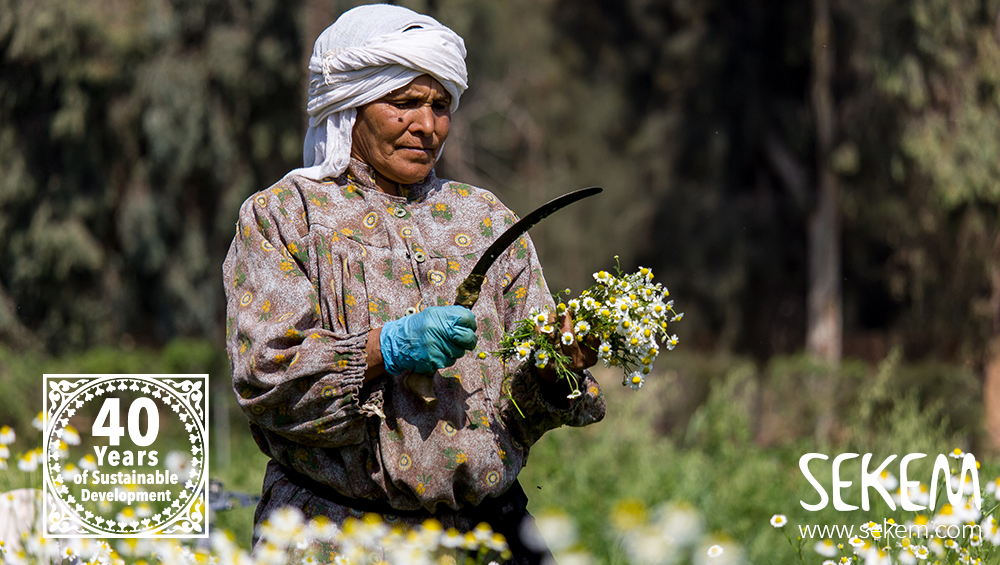The fields of white flowers have already become a trademark of SEKEM. Matricaria chamomilla, better known as chamomile, can be found in nearly every household – whether as soothing tea or as a remedy for stomach and intestinal complaints – chamomile is versatile and popular, also in agriculture.
Egypt is one of the world’s most important cultivating countries of the white-flowered medicinal herbs. Since the 1970s, SEKEM has been cultivating chamomile fields: totally about 140 tons of biologically dynamic chamomiles SEKEM produces each year.
Support and freedom
In the beginning of September, the chamomile seeds are sowed on a particularly nutritious sandy clay soil at the SEKEM farms. After 40 days, the then small plantlets move to the fields where they spend the winter. “We provide the plants with compost and natural preparations – according to the Biodynamic guidelines,” says the farmer Mahmoud Abd El Gawad. Because of his decades-long experience in Organic farming, the longtime SEKEM employee has taken over a leading role. “I really appreciate the fact that we have many freedoms in SEKEM and can implement our own ideas. This is not guaranteed in other Egyptian farms,” says the 56-year-old. Mahmoud is the father of five children, two of whom have attended the SEKEM School. “This is also an advantage here in SEKEM“, he says, “I was not only financially supported to offer my children a holistic education, but also learned a lot from the extensive knowledge that SEKEM shares with the employees.”
“Compared to conventional farms, we can save up to 40% of water,” Angela Hofmann.
Conscious handling of water
Among others, Mahmoud Abd El Gawad is responsible for the chamomile being properly irrigated. For this purpose, he receives support from irrigation experts, who deal exclusively with the optimal liquid supply. “Chamomile does not need a huge amount of water, but since Egypt is a country which struggles with severe water scarcity, we do not want to waste it,” says Angela Hofmann. The farmer and Biodynamic cultivation expert continues: “Even if we – compared to conventional farms – can save up to 40% of water, our employees regularly receive trainings on the best irrigation methods.”
Natural fertilization
During the winter months not only the chamomile grows, but also the weeds. Bugs like caterpillars and snails like the young plants. “For chamomile weeds are only a problem in the first months of cultivation,” Mahmoud knows. “Then we go through the fields with a chipper.” To keep the desert soil as fertile as possible, SEKEM fertilizes it with biological compost or with Vinasse, a waste product of the sugar production.

In January, the first chamomile flowers slowly show up. However, these young sprouts are immediately cut off again. Angela Hofmann: “As a result, the plants branch out and become more thick.” Only a month later, the actual harvest starts. 40 people per Feddan (about 0.42 hectares) are then active on SEKEM. “We use harvesting machines, but since these are not particularly thorough, we always have some assistants from the surrounding villages who help us to do the fine work during the months February and April,” explains Mahmoud. The so-called chamomile children can also be found in the SEKEM fields. At the first moment this is probably a frightening picture – SEKEM and child labor? No, of course not!
SEKEMs chamomile children
The Chamomile Children’s Project has been launched more than twenty years ago. At that time, children from poor families regularly came to SEKEM and asked for work. SEKEM initially refused this strictly, but then found that the children went to other places. There, they had to work hard on other plantations and fields. In order to prevent this, SEKEM has created an alternative: Under the supervision of a social worker, the children do easy work in the morning hours and get a daily wage for this – sponsored by the SEKEM Development Foundation (SDF). The rest of the day they participate in SEKEM School. The intention is to provide the children both with the necessary salary for their family and access to education. The few hours of easy work in the morning are necessary so that the other children, who go to SEKEMs comprehensive school and pay school fees, do not feel disadvantaged. And the project makes an impact: At the beginning there were always around 100 chamomile children – today there are fewer than 20. This is a great success.

If the chamomile carries new flowers about two weeks after the first cut, it can be harvested again and again in this cycle until the beginning of May. Until the next season, the SEKEM chamomile fields are then treated with a different plant family according to the biodynamic regulations. “This can be, for example, clover, grain or even quinoa,” says Angela Hofmann. This sequence of plants promotes the fertility of the soil.
Further processing in SEKEM
The harvested chamomile flowers are dried in a shadow house on the SEKEM farm, then dried in a special oven, before they are finally processed in the SEKEM company Lotus. At Lotus, the income from all SEKEM farms as well as those from the contract builders, who also operate with the aid of SEKEM on the principles of Biodynamic agriculture. At Lotus, the herbs, spices and seeds are cleaned, crushed and finally sent. 126 tons of chamomiles are exported. Only nine tons of the medicinal plants are processed in SEKEM to medicinal tea and classic chamomile tea. The remains of the harvest are, by the way, used for composting or are used as a straw for livestock breeding.
SEKEM has always been aware of the importance of chamomile as a healthy and natural remedy and uses it in many areas. Combined with the Biodynamic cultivation, the chamomile is not only for agriculture, but also for humans a completely profitable plant, which will surely also be found in the future in the home pharmacies and tea assortments around the world.
Christine Arlt
Learn more about the “Chamomile Children”
Organic Cotton as a Sustainable Alternative
What SEKEM is doing to end hunger, achieve food security and improved nutrition

